
NBC sets new capital, risk rules for banks, financial institutions
July 4, 2023Latest News
The National Bank of Cambodia (NBC) yesterday released two proclamations that set new requirements for depositing-taking banks and financial institutions to strengthen the quality of their capital to increase the effectiveness of preventing main banking risks and assess credit risks at lower rates to boost the economic growth by supporting the private sector in the economy.
The two proclamations launched include regulatory capital of deposit-taking banks and financial institutions and a proclamation on credit risks for capital adequacy ratio of deposit-taking banks and financial institutions, which have been prepared in accordance with international standards.
The two documents were issued as an improved part of the capital adequacy frameworks for depositing-taking banks and financial institutions in the context, development and vision of the banking and financial systems, laws and regulations that are applicable in Cambodia, which would contribute to increasing the public confidence on the country’s banking systems.
A technical official at NBC told Khmer Times yesterday that the first proclamation sets restructuring of components and methodologies of calculation of regulatory capitals of deposit-taking banks and financial institutions to enhance both quantity and quality of the capital to cover losses in case of going-concern and settlement of debts in case of gone-concern.
“The first proclamation sets the requirements for the acknowledgement of financial instruments in different classes that would help the target banks and financial institutions strengthen their capital and resilience against risks such as credit risks, operations risks and market risks, which would be able to protect depositors, debtors, investors and institutions themselves,” the official said.
The requirements would enable the financial instruments of deposit-taking banks and financial institutions in Cambodia to be acknowledged in tier 1 capital that would enable them to cover losses in the going-concern scenario or during operations, or tier 2 capital that enables them to cover losses on the gone-concern scenario or in process of operations closures.
Article 8 stipulates the components of the regulatory capital, saying that the total regulatory capital is composed of the tier 1 capital that includes common equity tier 1 capital, which is considered the best quality capital as it would enable those banks and financial institutions to cover immediate losses on the going-concern scenario with six sub-components including retained earnings, audited accumulated other comprehensive income and disclosed reserves.
The regulatory capital is composed of tier 2 capital which is its second component, according to the proclamation. “The requirements to acknowledge the regulatory capitals are set in the proclamation, but each or some requirements are applicable dependently on sub-components. Let’s say this requirement is for these sub-components. So, it is difficult to explain,” added the official.
However, the official pointed out that deposit-taking banks and financial institutions are required to fulfill 14 requirements for their regulatory capital to be acknowledged as the common equity tier 1 capital including capital instruments that are the last settlement in case of liquidation of the institution. “It is too technical to explain to others.”
He went to add that there are eight requirements or conditions for the acknowledgement of the capital of deposit-taking banks and financial institutions as tier 2 capital such as capital instruments that have at least five years of maturity and capital that is not guaranteed by issuers or relevant institutions or under any agreement that increase privilege in legal or economic payment same as depositors and general debtors of institutions.
The second proclamation lowers the highest risk weight rules from 100 percent or over 75 percent for registered micro, small and medium enterprises, 85 percent for businesses registered in agriculture, education and health care sectors, 80 percent for green finance projects and zero percent for government bond issuance and credit guarantee schemes such as Credit Guarantee Corporation of Cambodia (CGCC).
Chea Serey, NBC Deputy Governor, said last Thursday before the issuance of the two proclamations that these documents would contribute to the development of Cambodia’s economy as they would enable banks and financial institutions to release more loans to businesses that are registered with the Ministry of Commerce (MoC), General Department of Taxation (GDT) and other relevant institutions.
“The two proclamations will help small and medium enterprises receive finance at reasonable interest rates as they set incentive mechanisms for banks and financial institutions to release loans to [businesses in different sectors] agriculture, green financing and consumers-friendly loans such as school fee payment, transportation vehicle purchase, etc., but they have to be commercially registered and have proper accounting statements,” Serey added.
Credit to: Khmer Times, Publish on 04 July 2023
